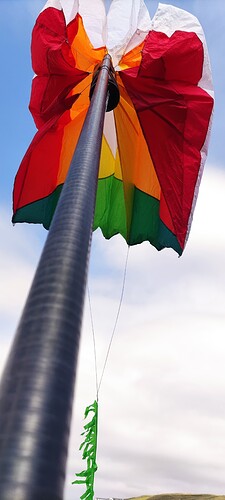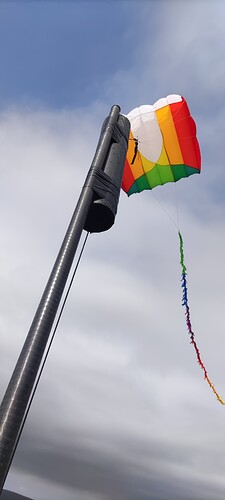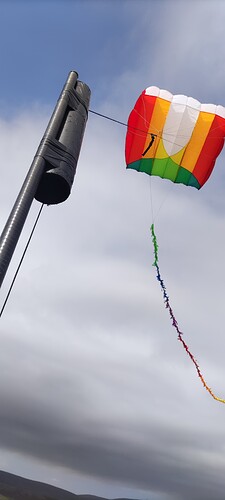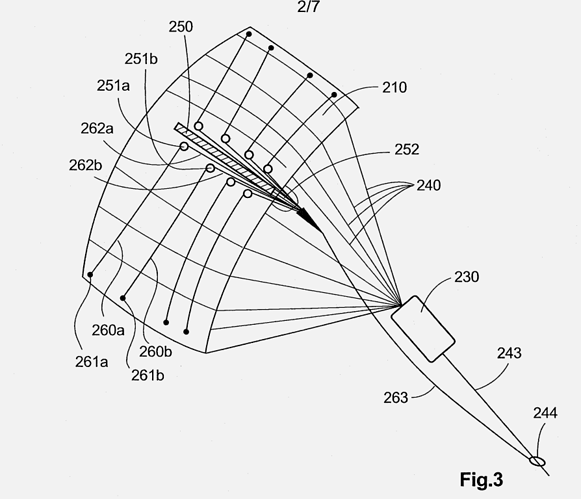From their website
The SkySails Group GmbH has sold the SkySails Marine Performance GmbH to a consortium from the shipping industry. The new company will continue business as of now under the new name of Albis Marine Performance GmbH.
The sale is related to SkySails’ increasing focus on the development and production of airborne wind energy systems for power generation. Stephan Wrage, Managing Director of SkySails Group GmbH: “The shipping industry is facing a huge challenge with the IMO requirements to reduce CO2
2 Likes
Wow, here on the Ranch, we call that switchin’ horses midstream. Yeee-haw! Ride 'em Cowboy! Mission creep? One click leads to another. I found myself watching their video. When I saw the nose of the kite released from its tower (tower? b-b-but I thought…), there was a wire (barely visible) still connecting the nose of the kite to the tower, that looked like it was reeling out with the kite. When I saw the kite return to the tower, this thin wire was, again, connected to the nose of the kite, being used to pull the kite toward the tower and secure it to the tower. I guess maybe I just haven’t been paying attention, but does anyone know if this extra wire remains connected to the kite during its entire cycle, from launch to landing? Does it have a separate reeling system? I almost clicked on asking the question from their FAQ section of their website, but it started looking too complicated, so I figured maybe someone here would know the answer.
My understanding is indeed that the extra line is connected the whole time. Seems quite smart to me.
It’s also shown in some of their patent drawings if I recall correctly.
If they were really brave, then they might use said line to reel in the kite in doing the retraction phase. The lines would probably be pretty messed up after that ><z
I don’t think the nose line is connected the whole time…
You can see a fairly large loop of slack line bridle (presumably this line) while it’s flying normally
ps
double check the recovery part of the video… The turbines in the background were running backwards. It’s reversed video of a launch.
So there is presumably some other more complex way of recapturing this nose line and
…returning it to the top of the mast at recovery
or
…pulling it to collapse the internal structure back to the stowage shape
1 Like
hmm
According to these drawings, the lines is attached around the main tether with a loop as you say. I believe there is another patent which also shows part of the GS
1 Like
Kinda makes sense because
You don’t want to be pulling that line and collapsing the kite
Also
the forces on a mast tip make it hard to keep the mast raised to completely recover the kite until it is down and de-powering
The mast launch helps to keep a launch viable in low wind and out of turbulence
See this superdirty prototype for our backline bot / lifter launcher
3 of the parts came for free
pipe and dog leash found on shore
mast donated
small kite - legitimate
1 Like
I do see the turbines in the background spinning backwards for a brief shot. They are also facing a different direction, but yes, reverse rotation. However, right at 2:40, when the kite is pulled into the tower, it looks to me like forward video, and the way the kite collapses against the tower looks like a forward-time impact, pulled into the tower by the nose line… If the nose line is connected through the whole flight, it seems that it might affect steering. Seems like managing the tension and slack on that nose line would be an entire job in itself, and it would need its own reel? Or it’s own slot on the main reel? Or maybe they do not actually have the landing part worked out yet? Seems puzzling to me.
1 Like
by means of a releasable
ring element 244
wind in untill you can catch the ring, take it up and pull the line to collapse the canopy
Wow, grab the golden ring, and win a prize, like on a merry-go-round.
Thanks for that quick answer, Roddy.
As I check the video again though, every shot seems like a different configuration. At one moment, the nose-line is attached to the gathering point of all the regular lines below the kite, then in the next shot you see that same line hanging slack from the tip of the boom. Possibly a case of high cranial density on my part, but I’m still not seeing how it works, or is supposed to work. I was also surprised to see the entire shipping container and tower rotate as a unit (base station yaw bearing) to face downwind. So I guess it all involves more than just dropping a shipping container off and opening it up. Well I guess it just goes to show you I have not really been paying close attention to any operational details.
In this debunking of bladeless wind devices (dated March 22, 2021), Paul Gipe also wrote about SkySails.
Going for a trifecta, the Guardian then heads on over to Germany and its SkySails. I single out SkySails in my book for their attempt to use sails for ship propulsion. It was the one example of “airborne” wind energy that I thought had promise. Apparently, they’re still around. Most other airborne wind energy companies have failed. Most spectacularly, Google abandoned its Makani kite program in early 2020, an albatross—it much resembled—that burned through millions of the search engine’s money.
Barely casts a shadow. Check.
Whoa, that’s another new one I’ll have to add to the inventor’s checklist. The Spanish developers of the sky vibrator missed a lick there. They don’t cast much of a shadow either. I’ll bet those Alpha 311 VAWTs don’t cast a shadow as well—with or without wind.
SkySails, not to be outdone by the Spanish newcomers with their fossil fuel backers, notes that German utility RWE’s partnership with the firm will raise their kite’s power from its current 100 kW to 200 kW up to the megawatt size. That’s the same RWE that backed Quiet Revolution. RWE’s still at it too.
The Guardian packed a lot into one puff piece—three revolutionary inventions in one go. That doesn’t happen often.
Earlier in the article, about RWE:
Recall all the hoopla around the British inventors of the sleek VAWT Quiet Revolution and its backing by German utility RWE. As I note in my book, RWE wasn’t a significant developer of wind energy in its home market—one of the largest wind markets in the world at the time. In fact it was an ardent opponent of wind energy. When RWE finally pulled their support, Quiet Revolution quietly disappeared. Typically the investment in small wind by electric utilities or oil companies has been the kiss of death.
This article resembles, in its argument, @dougselsam’s debunking Comments. The signs of failures are identified, but for the causes, concerning the AWE sector for power generation, and in addition to Doug’s comments: Barnard's predictions.



